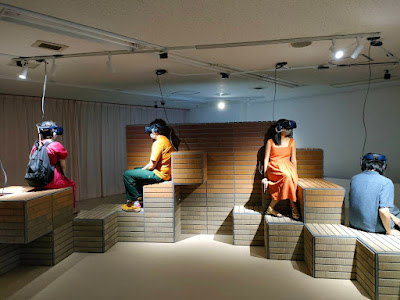一位來自金三角的演員 The Actor from Golden Triangle
虛擬實境 、鏡面裝置、雙頻道錄像裝置Virtual reality, mirror installation, Two-channel installation. 9'53". 2023
《一位來自金三角的演員》聚焦於金三角地區的歷史、神話和當代地緣政治,藝術家從傳統泰北民族中的罌粟花傳說延伸到COVID-19期間邊境山區罌粟田的再度擴張,融合說唱和泰國傳統蘭納表演,交織出此一敘事並透過虛擬實境呈現。
藝術家邀請了泰國演員Oak Keerati參與此新作。Oak曾參演《湄公河行動》和《泰國洞穴救援》,兩者皆講述了在泰北地區所發生的事件。在VR裝置中,Oak的虛擬形象身穿動作捕捉服,化身成他曾演過的角色,甚至化身為賭場老板,反映了湄公河周邊新興的經濟特區。他同時也是鴉片之家(House of Opium)的經營者,藝術家在鴉片之家中選定其中一個展間和一些與鴉片相關的文物進行3D掃描。同時,Lanna Youth Conservation Team (ทีมงานเยาวชนรักษ์ศิลป์ล้านนา)也應邀在航行於湄公河的船上進行傳統的打擊演出,鼓聲與說唱融為一體,影片中出現在森林裡的神秘生物「Toh」則反映佛教傳說中的喜瑪潘(Himmapan or Himavanta)森林。
此作品以虛擬實境(VR)和錄像裝置呈現。VR裝置需要兩人一組一起佩戴,提供觀眾沉浸式的共享體驗,兩位VR體驗者的虛擬形象將隨著Oak的外貌而變,而體驗者本身也成為其他觀眾眼中作品的一部分。藝術家在這個VR作品中匯聚了與泰北相關的多樣元素,連結了傳統與現代、神話與歷史的範疇,突顯了邊境山區如何轉變為一個複雜的數位經濟區,且具有地緣政治和數位時代相互交織的「開放世界」雙重涵義。
This work focuses on the history, myths, and contemporary geopolitics of the Golden Triangle. It weaves a narrative that traverses from the poppy folklore in traditional northern Thai tribes to the recent proliferation of poppy fields in the border mountainous regions during the COVID-19 pandemic. The artist presents this theme through VR, blending rap and traditional Thai performances.
The artist extended the invitation to the Thai actor Oak Keerati. Oak Keerati appeared in the films "Operation Mekong" and "Thai Cave Rescue", both about the happenings in Northern Thailand. In the VR installation, Oak's avatar is in a motion capture suit, transforming into these film characters and even into a casino owner, reflecting the Special Economic Zone emerging around the Mekong River. He and his mother also run the House of Opium contributed 3D-scanned space and opium-related artefacts within the work. The Lanna Arts Conservation Youth Team is also invited to perform traditional drumming on the boat sailing the Mekong River, with the drumbeat merging with the rap compositions, and in the forest as a mythical creature, Toh, reflecting the Buddhist legend of the Himavanta forest.
This work is presented in both VR and video installation. The VR device must be worn in pairs, offering a shared immersive experience with a changing avatar that changes their appearance in the same way as Oak does. Those who wear VR also become part of the work in the eyes of other viewers. The artist brings together these multifaceted elements tied to Northern Thailand in this VR work, bridging the realms of tradition and modernity, myth and history, highlighting the frontier mountainous region transforms into a sophisticated digital economy zone with the dual connotations of an 'open world' of intertwined geopolitics and the digital age.
《一位來自金三角的演員》聚焦於金三角地區的歷史、神話和當代地緣政治,藝術家從傳統泰北民族中的罌粟花傳說延伸到COVID-19期間邊境山區罌粟田的再度擴張,融合說唱和泰國傳統蘭納表演,交織出此一敘事並透過虛擬實境呈現。
藝術家邀請了泰國演員Oak Keerati參與此新作。Oak曾參演《湄公河行動》和《泰國洞穴救援》,兩者皆講述了在泰北地區所發生的事件。在VR裝置中,Oak的虛擬形象身穿動作捕捉服,化身成他曾演過的角色,甚至化身為賭場老板,反映了湄公河周邊新興的經濟特區。他同時也是鴉片之家(House of Opium)的經營者,藝術家在鴉片之家中選定其中一個展間和一些與鴉片相關的文物進行3D掃描。同時,Lanna Youth Conservation Team (ทีมงานเยาวชนรักษ์ศิลป์ล้านนา)也應邀在航行於湄公河的船上進行傳統的打擊演出,鼓聲與說唱融為一體,影片中出現在森林裡的神秘生物「Toh」則反映佛教傳說中的喜瑪潘(Himmapan or Himavanta)森林。
此作品以虛擬實境(VR)和錄像裝置呈現。VR裝置需要兩人一組一起佩戴,提供觀眾沉浸式的共享體驗,兩位VR體驗者的虛擬形象將隨著Oak的外貌而變,而體驗者本身也成為其他觀眾眼中作品的一部分。藝術家在這個VR作品中匯聚了與泰北相關的多樣元素,連結了傳統與現代、神話與歷史的範疇,突顯了邊境山區如何轉變為一個複雜的數位經濟區,且具有地緣政治和數位時代相互交織的「開放世界」雙重涵義。
This work focuses on the history, myths, and contemporary geopolitics of the Golden Triangle. It weaves a narrative that traverses from the poppy folklore in traditional northern Thai tribes to the recent proliferation of poppy fields in the border mountainous regions during the COVID-19 pandemic. The artist presents this theme through VR, blending rap and traditional Thai performances.
The artist extended the invitation to the Thai actor Oak Keerati. Oak Keerati appeared in the films "Operation Mekong" and "Thai Cave Rescue", both about the happenings in Northern Thailand. In the VR installation, Oak's avatar is in a motion capture suit, transforming into these film characters and even into a casino owner, reflecting the Special Economic Zone emerging around the Mekong River. He and his mother also run the House of Opium contributed 3D-scanned space and opium-related artefacts within the work. The Lanna Arts Conservation Youth Team is also invited to perform traditional drumming on the boat sailing the Mekong River, with the drumbeat merging with the rap compositions, and in the forest as a mythical creature, Toh, reflecting the Buddhist legend of the Himavanta forest.
This work is presented in both VR and video installation. The VR device must be worn in pairs, offering a shared immersive experience with a changing avatar that changes their appearance in the same way as Oak does. Those who wear VR also become part of the work in the eyes of other viewers. The artist brings together these multifaceted elements tied to Northern Thailand in this VR work, bridging the realms of tradition and modernity, myth and history, highlighting the frontier mountainous region transforms into a sophisticated digital economy zone with the dual connotations of an 'open world' of intertwined geopolitics and the digital age.








































